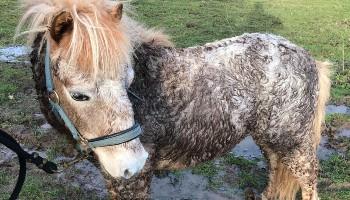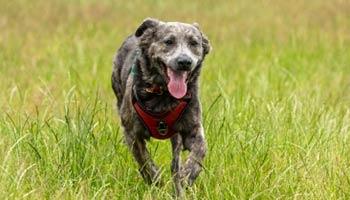9 tips for living with blind dogs
On International Blind Dog Day, our RSPCA animal life magazine editor, Hannah Doyle shares fond memories of her dog Dave - and offers advice on caring for blind and visually challenged pets.
Could our dog be going blind?
The first sign that something was wrong came one evening as my husband and I sat watching TV. Our beloved dog Dave positioned himself in front of us and barked. And barked. And barked.
A seven-year-old miniature dachshund with a big personality, attention-seeking wasn't unusual. However, on this occasion, nothing would satisfy him. Not a trip outside, a treat, his favourite chew or even fuss and attention. Something was distressing him, but we couldn't tell what...
The next morning as I took him for his walk, more worrying signs appeared. His normal enthusiastic walk was a slow, nose-to-the-ground shuffle. He kept veering off the path and a couple of times walked straight into bushes. Something was definitely amiss.
Fearing an inner ear infection that was affecting his balance (or worse, a brain tumour), I took him to our vet. The first thing she did was grab a handful of cotton wool balls and drop them, one after the other, in front of Dave's little face. At this point I was baffled, but I stood by, hopeful.
Our vet referred us for urgent eye tests
"I think it's his eyes," she announced. "He's not following the movement. He can't see."
Panic rising, I watched as our vet examined Dave further with a torch and using various other tricks to assess if he was responding visually. He wasn't.
She phoned and made an urgent referral to a veterinary hospital in the next county, which had eye specialists. Two days later, I watched as the specialist took Dave into a darkened room for a full assessment. I cried as she brought him back with the news.
He was completely blind. He couldn't see shapes or shadows, just blackness. The change was likely to have happened very quickly, over a matter of days. Now I understood what that barking had been about. He'd been confused and frightened, trying to tell us that something, suddenly, was wrong.
Dave was diagnosed with SARDS, Sudden Acquired Retinal Degeneration Syndrome. It's a rare and incurable condition but one that is seen more commonly in certain breeds of dogs - dachshunds being one of them.
My vet really helped to advise us on caring for a blind dog
I'm grateful to my brilliant vet for quickly recognising the signs and knowing what to do - and for her ongoing care over the following years. "Brilliant," she told me as Dave and I walked into her surgery for a check-up a few weeks later. "You're not carrying him. That's so important, well done."
From the start, she assured me that the diagnosis was a lot more difficult for my husband and I to take on board than it was for Dave. For dogs, smell and hearing are far more important senses than sight. I should encourage independence and resist the urge to baby him while taking every care to make his life comfortable - and so we did.
My then three-year-old twin boys practised crawling around our flat with blindfolds on so they could see what life would be like for their pet. We created a cosy, covered den for him to relax in - although that didn't stop him fearlessly climbing and sleeping in precarious locations, like the arm of the sofa.
Walks became a little slower and we stuck to open, flat ground. He seemed more happy on-lead, knowing that I was always close by. Being blind didn't stop his sense of adventure though and he loved to steal my sons' football and chase it until it burst.
I remember a particularly hot day when he took himself into the Thames for a swim! Most people we met had no idea he couldn't see and at times he was so capable we forgot, too.
Lovely Dave crossed the rainbow bridge, as they say, in 2015. What a special place he'll have in our hearts forever though. What lessons he taught everyone who knew and adored him, about the resilience of our canine companions.
Tips for caring for a blind or visually impaired dog
Unsure of what to do if your dog is going blind or is blind? Here are a few tips I picked up through books, vet advice, talking to other blind-dog owners, and trial and error:
- Don't move the furniture around at home. Your dog will quickly make a mind and scent map and be able to get around - unless you change things.
- Get down on all fours and crawl around looking for hazards, like sharp edges. It's a bit like baby-proofing your home (in fact, baby gates at the top of stairs are a great idea).
- Use your voice and talk to him all the time. You'll need new commands like, "careful" and "step up" and "step down" to teach dogs when a kerb is coming.
- Leave a radio on in the same place, especially if you go out. He can use the sound to orientate himself.
- Have a collar or tag made that states that he's blind. That way, should he get lost, whoever finds him will know that he's blind.
- Update his microchip information, too.
- You can also get leads, coats or bandanas that say 'Blind dog' or similar, to alert others.
- Falconry bells are useful out on walks - you carry them - so your dog always knows where you are. Or if you have other dogs, one of them could wear them.
- Don't forget your dog will still love to play - get some noisy toys and try scent work.
Coping with blindness and sight issues in dogs
Caroline Allen, our Chief Veterinary Officer (who also has a blind dog, Tilly), advises:
- Like humans, dogs can be affected by sight-limiting conditions, such as cataracts, glaucoma and infections. Although eyesight can deteriorate in old dogs, don't assume that any deterioration in vision is 'just due to their age' as it can be a sign of other problems. Equally, early treatment can reverse vision loss in some situations and so always speak to your vet if you have any concerns.
- Other conditions that can cause blindness include diabetes, tumours or brain disease.
- SARDs is a rare condition that causes sudden and irreversible blindness due to changes in the retina. It's diagnosed by an electroretinography (ERG). It's not known what causes it, although recently it's been suggested that the condition is caused by a malfunctioning immune system and that SARDs is an auto-immune disease.
- Signs your dog may be experiencing problems with their eyesight include disorientation; bumping into walls or furniture; pacing aimlessly or standing in one place looking lost. They may also be reluctant to use stairs or move much at all.
- If in any doubt, take your dog to a vet who can organise the necessary tests. You should see your vet urgently if you think your dog has become suddenly blind.
- As long as any underlying disease is managed, most dogs adjust well to blindness over a period of six to eight weeks. It's very possible for a blind dog with a caring owner to have an excellent quality of life.



